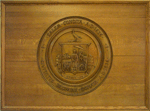Count Rumford: Difference between revisions
No edit summary |
No edit summary |
||
| Line 2: | Line 2: | ||
he left (abruptly) with the British in 1776. | he left (abruptly) with the British in 1776. | ||
He lived in Salem when he was young and a clerk in a Salem store. He lived in the Georgian Colonial | He lived in Salem when he was young and a clerk in a Salem store. He lived in the Georgian Colonial house (built in 1755) at 314 Essex St. Known as the Lindall- | ||
Gibbs-Osgood house in the book, Architecture in Salem. It has been known as the "Rumford House" and the "Red Cross" house. The American Red Cross | Gibbs-Osgood house in the book, ''Architecture in Salem''. It has been known as the "Rumford House" and the "Red Cross" house. The American Red Cross | ||
bought it in 1947 and used it until the mid 1990's when it was changed over to offices. | bought it in 1947 and used it until the mid 1990's when it was changed over to offices. | ||
He spent much of his life as an employee of the Bavarian government. He is primarily for the work he did on the nature of heat. Back in England, | He spent much of his life as an employee of the Bavarian government where he received his title, "Count of the Holy Roman Empire." | ||
Rumford applied his knowledge of heat to improve the heat coming from fireplaces. He made them smaller and shallower with widely angled covings so they | He is primarily known for the work he did on the nature of heat. Back in England, Rumford applied his knowledge of heat to improve the heat coming from fireplaces. He made them smaller and shallower with widely angled covings so they radiated heat better. It became known as the Rumford Fireplace. | ||
radiated heat better. | |||
Revision as of 10:54, 9 March 2012
Count Rumford, for whom the Rumford fireplace is named, was born Benjamin Thompson in Woburn, Massachusetts in 1753 and, because he was a loyalist, he left (abruptly) with the British in 1776.
He lived in Salem when he was young and a clerk in a Salem store. He lived in the Georgian Colonial house (built in 1755) at 314 Essex St. Known as the Lindall- Gibbs-Osgood house in the book, Architecture in Salem. It has been known as the "Rumford House" and the "Red Cross" house. The American Red Cross bought it in 1947 and used it until the mid 1990's when it was changed over to offices.
He spent much of his life as an employee of the Bavarian government where he received his title, "Count of the Holy Roman Empire." He is primarily known for the work he did on the nature of heat. Back in England, Rumford applied his knowledge of heat to improve the heat coming from fireplaces. He made them smaller and shallower with widely angled covings so they radiated heat better. It became known as the Rumford Fireplace.
See Also
Memoir of Benjamin Thompson, Count Rumford : with notices of his daughter by G.E. Ellis
Architecture in Salem by B. Tolles, p. 180
